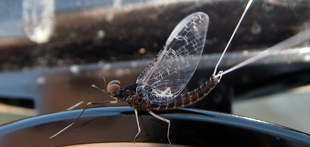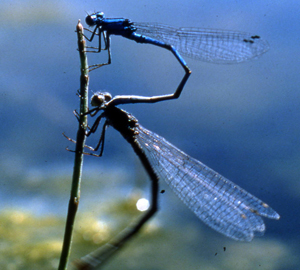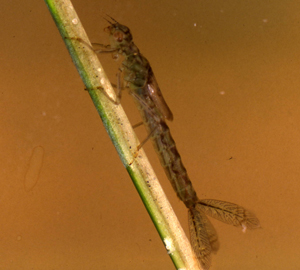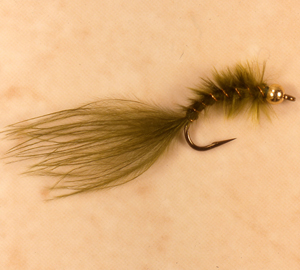|
|
|
Hatches - DamselfliesIntroduction
Life Cycle
Damselflies life cycles vary from 1 to 3 years in length. Larvae undergo numerous instars or molts during their development. At maturity, some larvae can reach over 35 mm in length. Juvenile and maturing larvae seek the cover provided by benthic and emergent vegetation growing on the shoal or littoral zones of the lake or stream.
Patches of longstem bulrush and cattail make excellent emergence sites. The nymphs crawl up the plant stems and out of the water. The skin of the now exposed larvae dries and splits along the back of the thorax which allows the adult or teneral form to emerge. Over the next several hours the newly emerged adult completes development and then flies off and away from the water. Adult damselflies can live for several months during which time they feed heavily on smaller flying insects such as mosquitoes and mayflies. Mating typically occurs within a couple of weeks of emergence. It is often preceded by intricate displays of courtship with the result of seeing adults flying around in tandem. Egg laying typically occurs on emergent or floating vegetation. The females use their ovipositor to create an opening in the plant stem into which eggs are deposited.
Fishing Strategies
Damselfly larvae are a prime food source of trout in stillwaters. Trout patrol the openings between the mats of submergent and emergent vegetation as they search out both juvenile and maturing larvae. The colour of damselfly larvae will vary with the habitat they are living in, so the angler should consider that when selecting the appropriate fly pattern. Damselfly larvae are most vulnerable to trout when they embark on the emergence swim to complete their life cycle. The observant angler can often see large numbers of sinusoidally swimming larvae in the upper layers of the water column. Trout will pick off the larvae as they make their way to the patches of bulrush or cattails. Even more exciting is watching trout hit or roll onto the stems of bulrush to knock off larvae or emerging adults into the water. The trout then quickly turn back to feast on the struggling insects. To top it off, this feeding action can occur in water only a meter in depth.
Damselfly larvae are not fast swimmers. They maintain a slow but steady side-to-side action whether swimming up off the lake bottom or moving horizontally through the water. A slow, steady hand twist retrieve with the occasional side-to-side twitch of the rod tip is usually all that is needed to attract the attention of a cruising trout. Fly patterns representing the larvae can vary from being quite simple to very realistic in design. Patterns may not have to be realistic during the first few days of the mature larval emergence swim but as the trout continue to gorge on the insects they can become quite selective as to size, shape and colour. The natural swimming action of marabou fibres makes this an excellent material to consider when tying either suggestive or more realistic larval patterns.
|
|
|
STILLWATER SEMINARS * GUIDING * HOSTED TRIPS
HATCHES:::Damselflies
|
|
|||||
 |
|
 |
|||
|
|


 Damselflies belong to the insect order Odonata. Members of the relatively primitive insect order are widely distributed from the tropics to the arctic. Worldwide, there are in excess of 650 species of this insect order. Odonata is broken down into two sub-orders: Anisoptera, the dragonflies and Zygoptera, the damselflies. Approximately 200 species of damselflies are found throughout their global range. Damselflies exhibit an incomplete metamorphosis which includes egg, larva (nymph) and adult stages. Larval habitats include the shallow or littoral zones of lakes, ponds, brackish waters and the slower reaches of rivers and streams. Damselfly larvae are easily distinguished by their long, slender bodies, distinct wing pads and well developed mouthparts. Larvae also possess 3 paddle-shaped caudal gills or lamellae located at the tip of the abdomen. These gills are an integral part of the respiratory system as well as acting as rudders or stabilizers during sinusoidal swimming activity. For many, our first encounter with adult damselflies was as kids chasing them around with butterfly nets along the edge of a lake or pond. These often colourful insects are identified by having long slender abdomens and 4 highly membranous wings that at rest are held along the back of the abdomen.
Damselflies belong to the insect order Odonata. Members of the relatively primitive insect order are widely distributed from the tropics to the arctic. Worldwide, there are in excess of 650 species of this insect order. Odonata is broken down into two sub-orders: Anisoptera, the dragonflies and Zygoptera, the damselflies. Approximately 200 species of damselflies are found throughout their global range. Damselflies exhibit an incomplete metamorphosis which includes egg, larva (nymph) and adult stages. Larval habitats include the shallow or littoral zones of lakes, ponds, brackish waters and the slower reaches of rivers and streams. Damselfly larvae are easily distinguished by their long, slender bodies, distinct wing pads and well developed mouthparts. Larvae also possess 3 paddle-shaped caudal gills or lamellae located at the tip of the abdomen. These gills are an integral part of the respiratory system as well as acting as rudders or stabilizers during sinusoidal swimming activity. For many, our first encounter with adult damselflies was as kids chasing them around with butterfly nets along the edge of a lake or pond. These often colourful insects are identified by having long slender abdomens and 4 highly membranous wings that at rest are held along the back of the abdomen. 

 Intermediate/slow sinking and floating fly lines are ideal for fishing damselflies. The intermediate sinking line is best used to imitate the larval swim from the lake bottom to the upper water column. Floating lines are perfect for matching the mature larval swim that occurs within the upper metre of water as the larvae make their way to emergent vegetation as well as for presenting floating adult patterns when being taken in shallow water.
Intermediate/slow sinking and floating fly lines are ideal for fishing damselflies. The intermediate sinking line is best used to imitate the larval swim from the lake bottom to the upper water column. Floating lines are perfect for matching the mature larval swim that occurs within the upper metre of water as the larvae make their way to emergent vegetation as well as for presenting floating adult patterns when being taken in shallow water. 

